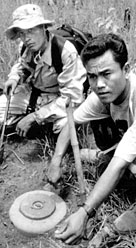To raise funds for the construction of a new Aggie-designed facility
for the Cambodian Land Mine Museum in Siem Reap, Cambodia, the Texas
A&M student chapter of the American Institute of Architecture Students
(AIAS) sponsored the "Vision 5K Run & Walk," Saturday, April 3 on
the Texas A&M University campus.
A&M architecture student involvement in the Cambodian project began last September when Richard Fitoussi, director of the Cambodian Land Mine Museum Relief Fund (CLMMRF), requested student designs for a new facility to replace the existing museum. Tackling the project were two A&M architecture design studios directed by Julie Rogers, who holds a Ph.D. in architecture and has a special interest in Southeast Asian art and architecture, and George J. Mann, the Ronald L. Skaggs Professor of Health Facilities Design.
Three years prior to accepting the project, Rogers had visited the
existing land mine museum and met its curator, Aki Ra, a former
child-soldier who, from the age of five, participated in the laying
of land mines for the Khmer Rouge, Vietnamese and Cambodian armies.
Ra has since devoted his life to removing the estimated 5-7 million
mines still hidden in the Cambodian soil. Since 1999, when he established
the Cambodian Land Mine Museum in Siem Reap, Ra has cleared more
than 6,000 land mines with little more than a wrench and a hammer.
His incredible collection of mine shells and bomb casings are on
display at the museum along with archives chronicling the rise and
fall of the Khmer Rouge and the genocidal horrors of Cambodia's
infamous "Killing Fields."
The Cambodian Land Mine Museum is dedicated to land mine awareness
and education. Ra, his modest museum and heroic endeavors, have
been widely reported throughout the world, including stories by
The Washington Post, The New York Times, CNN and the BBC. His story
has also been told in over 10 documentary features from eight different
countries.
Ra's dream is to expand his museum to incorporate land mine prevention programs, a prosthetic limb clinic and a land mine rehabilitation center.
Siem Reap, where the Cambodian Land Mine Museum is located, is home
to the Angkor Wat temple complex - ancient architectural structures
that draw 1.5 million tourists to the area each year. It is hoped
that a new attractive museum facility will draw some of the temple
tourists and thus greatly increase revenues to fund CLMMRF initiatives.
"His efforts are a small step toward eliminating a huge problem,"
Rogers said. "It is estimated that as many as 110 million land mines
are buried around the world. At the current rate of de-mining, it
is projected that it will take more than the next millennium to
remove them all."
Some of the highest concentrations of these mines are buried in some of the world's poorest countries —Afghanistan, Angola, and Cambodia. In Cambodia alone, a nation of approximately 11.2 million people, it is estimated between five to seven million landmines remain buried. There are more land mines in Cambodia today than there are children.
Last fall, a new design for the land mine museum facility, created by Roger's students Greg Caldwell and Luke Giesselmann, was selected by Ra and Fitoussi for further development.
"It was quite overwhelming to see how excited everyone became when we brought out Greg and Luke's design," Fitoussi said. "The design embodies modern Khmer architecture, but still retains an age-old traditional style which has been around for hundreds of years."
Last spring, Roger's undergraduate students refined the selected land mine museum design. They received assistance from professional architects Charlie Burris and Eva Read-Warden of Arkitex Studio in Bryan/College Station. They have also consulted with M.L. "Skip" Coody, associate professor of construction science.
To help realize their project and to aid in a cause that has deeply moved them all, the students created the the Architectural Incentives through Design (AID) Fund for the Cambodian Land Mine Museum Prevention and Rehabilitation Facility. It is estimated that the facility will cost about $50,000 to complete.
The students' work and their fundraising efforts are documented on the class Web site at http://cambodia.showviz.net. The site also has links to the Cambodian Land Mine Museum Relief Fund, the Land Mine Museum Web site and Aki Ra's life story. For further information about the race or how you can help, please contact Julie Rogers at (979) 690-1116 or jrogers@archmail.tamu.edu.
| |

Click on the picture above to
view student designs and earn more about Aki Ra (right) and
his Cambodian Land Mine Musuem.
|